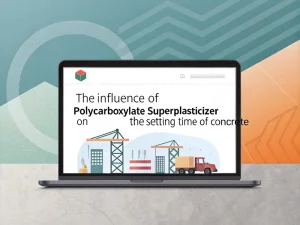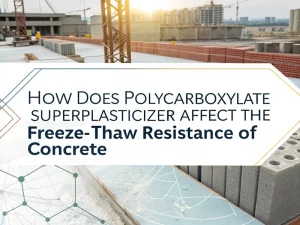
The Influence Of Polycarboxylate Superplasticizer On The Setting Time Of Concrete
Blog The influence of pol
Blog
Polycarboxylate-based concrete admixture is an important direction in the research of high-performance water-reducing agents for concrete today, and it is also the most promising concrete admixture for future development. At present, the primary raw materials for water-reducing agents on the market are unsaturated polyethers, among which the Isopentenyl alcohol polyoxyethylene fermentation (TPEG) series and the Methyl allyl alcohol polyoxyethylene ether (HPEG) series are the main ones.

These two polyether monomers account for over 90% of the raw materials of the water-reducing agent. So, the quality of TPEG 2400 polyether monomer plays a decisive role in its performance as a concrete admixture.
Effectively controlling the quality of TPEG 2400 is a key measure to ensure stable product performance and improve downstream application effects.
It requires collaborative efforts from multiple aspects, such as raw material selection, synthesis process control, storage condition optimization, and product testing enhancement.
As one of the core raw materials for synthesizing TPEG 2400, the quality of the starter directly affects the foundation of product quality. For isopentenol initiators, it is necessary to ensure that their purity reaches a very high level, and the impurity content should be strictly controlled within a very low range.
Strictly test its purity indicators to prevent impurities such as aldehydes and ketones from being mixed in. These impurities may cause side reactions during the synthesis process, leading to changes in the molecular structure and decreased product performance.
For example, aldehyde impurities may compete with epoxyethane for reactive sites, resulting in abnormal branched structures and weakening the dispersibility of TPEG 2400. Priority should be given to products from well-known suppliers whose production processes are standardized and quality control is strict, providing reliable guarantees for the purity of raw materials.
The quality of ethylene oxide cannot be ignored either. Its purity must be above 99%, and there is almost zero tolerance for impurities such as moisture, aldehydes, and peroxides.
Moisture can interfere with the polymerization process, altering the degree of polymerization and molecular weight distribution. In anionic ring-opening polymerization reactions, water can trigger chain transfer reactions, resulting in uneven molecular weight distribution and affecting the consistency of product dispersion performance. Aldehyde impurities may participate in side reactions, forming ether bonds or hydroxyl derivatives, reducing the retention rate of double bonds in the product and weakening its reactivity.
Peroxides may induce free radical reactions and disrupt the integrity of polymer chain structures. Establish a strict ethylene oxide receiving inspection process, use precision gas chromatography and other equipment to accurately determine impurity content, and ensure flawless quality of incoming raw materials.
Catalysts play a key role in the anionic ring-opening polymerization reaction of TPEG 2400 synthesis, and their dosage and quality directly affect the reaction rate, selectivity, and product quality.
Potassium hydroxide (KOH) is a commonly used catalyst, and its dosage needs to be precisely controlled, usually at 0.3% -0.6% of the mass of the starting agent isopentenol. Excessive dosage can exacerbate side reactions, generate more impurities such as polyethylene glycol (PEG), increase the content of PEG by-products in the product, reduce the retention rate of double bonds, and damage the dispersibility of the product.
Insufficient dosage leads to slow reaction initiation and progress, low production efficiency, and even incomplete polymerization, which affects the product’s molecular weight and performance stability.
Verify the catalyst’s activity regularly to ensure that it is maintained within a stable and efficient range, ensuring smooth and precise progress of the reaction.
Reaction temperature, pressure, and time are key parameters in polymerization reactions, closely related to product quality. The reaction temperature should generally be maintained between 100-140 ° C, which can ensure efficient polymerization reaction and avoid side reactions such as self-polymerization of ethylene oxide, molecular chain breakage or cross-linking caused by high temperature, resulting in abnormal molecular weight and uneven distribution of the product; If the temperature is too low, the reaction will be slow, the polymerization will be incomplete, and the product performance will not meet the standards.
The pressure is controlled at 0.2-0.5 MPa to provide a stable medium environment for the reaction and prevent pressure fluctuations from causing the dispersion of ethylene oxide or local uneven concentration, which affects the uniformity of the polymerization reaction and product quality consistency.
The reaction time is precisely set according to the reaction scale and equipment characteristics to achieve complete conversion of ethylene oxide and ideal polymerization degree. The reaction time for small reactors is about 4-6 hours, while large devices can be appropriately extended to 6-8 hours. The reaction parameters are continuously monitored and dynamically optimized during this period to ensure stable product quality.
The moisture content in the system is a key hazard affecting the quality of TPEG 2400, as it can trigger the hydrolysis of ethylene oxide to produce PEG by-products, altering the chemical structure and properties of the product.
Before the reaction, vacuum drying technology is used to remove the moisture from the raw materials and reaction kettle deeply, and the moisture content of the system is strictly controlled to below 0.03%. Before introducing ethylene oxide into the reaction vessel, an efficient drying tower and molecular sieve adsorption device are installed to double intercept moisture.
At the same time, during the reaction process, trace amounts of water generated by the reaction are removed promptly through vacuum distillation technology. The moisture content is strictly monitored throughout the process to ensure that the reaction system is free of water interference and maintains the purity and stability of the product quality.


The storage tank material for TPEG 2400 must have excellent chemical stability and sealing properties. Carbon steel storage tanks lined with stainless steel or corrosion-resistant materials are preferred. Tank design should avoid dead corners and gaps to prevent material accumulation and deterioration.
Equipped with a complete nitrogen sealing system, maintaining a slight positive pressure inside the tank, preventing oxygen from entering and causing oxidative degradation, and ensuring the stability of the product’s chemical structure.
Regularly inspect storage tanks’ sealing and corrosion resistance, develop inspection and maintenance plans based on storage duration and material turnover frequency, and promptly repair or replace damaged components.
The storage environment temperature should be controlled within the constant temperature range of 10-30 ° C to avoid significant temperature fluctuations that may cause thermal expansion, contraction, accelerated aging, or changes in the product’s physical and chemical properties. Install a temperature control system to monitor and adjust the warehouse temperature in real-time.
The humidity should be maintained within 40% -60% relative humidity to prevent excessive humidity from causing the product to absorb moisture, hydrolyze, and deteriorate. Equipped with dehumidification equipment, intelligent dehumidification is carried out according to environmental moisture to ensure a dry and stable storage environment and maintain constant product quality.
Adhere to the first in, first out principle to manage the storage of TPEG 2400 and strictly limit the product’s storage duration. Considering that product quality gradually decreases with the extension of the storage period, it is recommended that the maximum storage period not exceed 6 months.
Establish a dynamic inventory management system to accurately track product entry time, batch, and inventory quantity, clean up expired products for factory inspection or proper handling, and prevent products with quality deterioration caused by storage expiration from entering the market.
As a leading TPEG 2400 supplier in China, we strictly control every production process and are committed to producing the highest quality products.
At the same time, we also have HPEG 2400, EPEG 3000, welcome to inquire!

The Influence Of Polycarboxylate Superplasticizer On The Setting Time Of Concrete
Blog The influence of pol

How Does Polycarboxylate Superplasticizer Affect The Freeze-thaw Resistance Of Concrete?
Blog How does polycarboxy